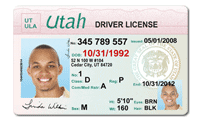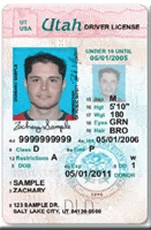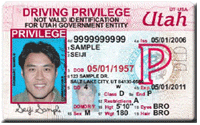
 |
|
INTRODUCTION TO DRIVING
We start this class by examining the statistics of factors that are responsible for accidents on Utah roadways.
THE TOP FIVE LEADING CAUSES OF DEATH ON UTAH ROADS
Speed too fast 42%
Failed to keep in proper lane 35%
Unrestrained Occupant 34%
Driving under the influence 16%
Failed to Yield Right of Way 11%
THE TOP FIVE LEADING CAUSES OF CRASHES ON UTAH HIGHWAYS
Following too closely 22%
Teen Driver Crashes 20%
Inclement Weather Crashes 18%
Failed to Yield Right of Way 18%
Speed Too Fast 17%
THE TOP FIVE LEADING CAUSES OF DEATH ON UTAH HIGHWAYS (TEENAGERS)
Ran off the road 40%
Speed Too Fast 23%
Driving Under the Influence 20%
Failed to keep in proper lane 20%
Swerved or Evasive Action 20%
THE TOP FIVE LEADING CAUSE OF CRASHES ON UTAH HIGHWAYS (TEENAGERS)
Following too Closely 21%
Failed to yield right-of-way 18%
Speed too fast 11%
Driver distraction 10%
Failed to keep in proper lane 9%
Utah Highway Patrol on OvercorrectionDefensive Driving
Always be prepared to react to the other driver driving errors. Do not expect the other driver to do what you think he/she should do. Do not think you know what he/she is going to do. If you cannot avoid a crash, remain calm and try to choose the least dangerous situation.Aggressive Driving
Aggressive driving is the operation of a motor vehicle in a manner that endangers or is likely to endanger persons or property. Persons doing any of the following may be committing acts of aggressive driving.
- Speeding
- Running red lights and stop signs
- Tailgating
- Passing on the shoulder of the road
- Cutting off another vehicle
- Slamming on brakes in front of a tailgater
- Improper hand or facial gestures at other drivers
- Yelling
- Repeatedly honking the horn
- Repeatedly flashing headlights
Aggressive driving is a serious problem that is responsible for many traffic crashes and fatalities. It is to your benefit to avoid aggressive drivers and potentially dangerous situations. If you encounter an angry or aggressive motorist:
- Do not retaliate or in any way engage the other driver. Get out of the way.
- Do not make eye contact.
- Keep your doors locked and your windows up.
- Keep enough space between you and the vehicle in front of you to pull out from behind.
- Do not underestimate the other driver’s potential for aggression.
Anyone can become an aggressive driver. Do not let stress and frustration get the best of you while driving.
- Be patient and courteous.
- Do not drive when angry, overtired or upset.
- Allow extra time to get to your destination.
- When possible, change your schedule to avoid congestion.
- Listen to relaxing music or books on tape.
- Give other drivers the benefit of the doubt - all drivers make mistakes.
- Avoid all conflict, even if you are right.
Road Rage
The following are common manifestations of road rage:
- Generally aggressive driving, including sudden acceleration, braking, and close tailgating
- Cutting others off in a lane, or deliberately preventing someone from merging.
- Chasing other motorists
- Flashing lights and/or sounding the horn excessively.
- Driving at high speeds in the median of a highway to terrify drivers in both lanes.
- Rude gestures such as giving the finger.
- Shouting verbal abuse or threats.
- Intentionally causing a collision between vehicles.
- Hitting other vehicles.
- Assaulting other motorists, their passengers, cyclists or pedestrians
- Exiting the car to attempt to start confrontations, including striking other vehicles with an object.
- Threatening to use or using a firearm or other deadly weapon.
- Throwing object from a moving vehicle with the intent of damaging other vehicles.
Reckless/Distracted Driving
One is guilty of careless driving if the person commits two or more moving traffic violations with a single continuous period of driving or commits a moving traffic violation while being distracted by cell phone, texting, putting on make-up, or searching for an item in the vehicle.
- Operation of an automobile in a dangerous manner
- Speeding or going too fast in spite of adverse road condition, even though within the posted speed limit
- Cutting in and out of traffic
- Failure to yield to other vehicles
10 Common Driving Distractions
Drowsy Driving
Operating a vehicle safely demands that the driver concentrate on driving. The person should be rested, calm and not under the influence of alcohol or other drugs. One of the greatest hazards of roadway driving is drowsiness. Lack of sleep or fatigue affects your ability to safely drive your vehicle. When taking a long trip, avoid drowsiness by stopping frequently for refreshment, exercise or nap.
Being Pulled Over by Law Enforcement
- Slow down and pull over safely as soon as possible.
- Stay in the driver’s seat with both hands clearly in sight on the steering wheel until the officer instructs you otherwise or the traffic stop is complete. Do not exit your vehicle unless asked to do so. Getting out of your vehicle can be perceived as aggressive behavior and a threat to the officer’s safety. Turn on your interior light if stopped at night.
- Comply with the officer’s request to see your driver’s license and proof of insurance. If these items are in the glove box or under the seat, inform the officer of that fact and then follow his/her directions before retrieving them.
- If you are issued a ticket requiring a signature, sign it. Signing a ticket is not an admission of guilt–only an acknowledgment of receiving the ticket.
- If you are suspected of drunk driving, cooperate with the officer(s) on the scene. If you refuse to submit to breath, blood or performance tests, your refusal could result in loss of driving privileges.
- Get out of the automobile only if asked to do so.
- Be aware that you may have committed some minor traffic violation without realizing it, there may be some problem with your vehicle of which you are unaware, or you might be driving a vehicle that is similar to one used in a serious crime. Many officers will not provide specific reasons for the stop until they have your license and insurance card in hand. Therefore, they will avoid having to debate the reason for the stop before they receive these items from you.
- If you wish to offer an explanation of your circumstances when stopped, do so before the officer returns to his vehicle. The officer cannot void the ticket once it has been written. Cooperate during the incident even if you believe you haven’t committed an offense. If you believe you have been treated unfairly, present your case in traffic court and not to the officer along the roadway.
- You are to be treated with dignity and respect by the officer. If you believe that an officer has acted inappropriately during a traffic stop or other encounter, you should report that conduct as soon as possible to the officer’s superiors.
- Officers are required to provide their names and badge number upon request.
Be polite and cooperate with any law enforcement officer when pulled over for routine traffic check. The video below shows what could happen if one refused to cooperate.
Cooperate with Law Enforcement Officer when stopped
Driving Under the Influence - DUI
Alcohol and other drugs give you a false sense of confidence. You are not likely to worry about the consequences while you already are impaired or intoxicated. The time to consider them, and how to avoid them, is before you are under the influence.
- If you regularly go to social events with the same group of friends, rotate drivers. Each friend takes a turn being the "designated driver" who does not drink alcohol.
- Arrange to stay overnight or ride home with a friend who does not drink. Make plans ahead of time, before you start drinking.
- Before you begin drinking, give your car keys to a friend who does not drink and who will not let you drive after drinking.
- Call a cab or use public transportation to get home
- Listen to your friends. Accept their help. If they warn you about not driving, take their concern seriously. Do not laugh it off or become angry.
- Cancellation - termination of a license issued through error or fraud or for which consent has been withdrawn
- Careless Driving – is distracted driving. One is guilty of careless driving if the person commits two or more moving traffic violations with a single continuous period of driving or commits a moving traffic violation while being distracted by cell phone, texting, putting on make-up, or searching for an item in the vehicle.
- Commercial Driver License – a license which allows the holder to operate any vehicle with a GVWR of 26,001 lbs or more, or to transport more than 15 passengers, hazardous materials, doubles/triples, bulk liquids (tankers), or school buses.
- Disqualification – a temporary or permanent withdrawal of a commercial driver license.
Limited-term Identification Card – the evidence of the privilege to drive a motor vehicle and was obtained by providing evidence of the lawful presence in the United States by an individual who is not a U. S. Citizen, a U.S. National, or a Legal Permanent Resident Alien.



Answer the following from the Utah Driver Handbook
- How old must you be to have a class A License? - 16 years
- What makes you a resident of Utah? – make Utah home, and are employed in Utah
- What is the Driver License Compact? - is a league of 45 states plus Washington DC that provides guidelines in driver license matters, exchange driver records and forward convictions for traffic offenses to the driver’s home state.
- Who will not be given a Utah Driver License?
a) If you are under the required age of 16b) If your driving privilege is denied, suspended, revoked, or disqualified
c) If you are unable to understand highway signs in the English language
d) If you are physically or mentally unable to drive safely
e) If you have not passed the required examinations
f) If you have a traffic ticket or other warrant which has not been settled
g) If you are not a resident of the state
h) If you are under 18 years of age, and have not held a learner permit issued for six months.
- Who is considered a minor in Utah? - A person younger than 17 years of age.
- What laws apply to minors – A person younger than 17 years of age may not operator a motor vehicle upon any highway between the hours of 12:00 am and 5:00 am
- What is a Learner’s Permit? - Learner’s Permit is a certificate issued to a person 15 years or older who want to obtain a Utah driver license. The permit allows the individual to take driver education and drive a car under the supervision of a certified instructor and a legal guardian or parent.
- Who may drive with a minor who has a Learners Permit?
a) an approved driving instructor
b) the applicant’s parent or legal guardian who is a licensed driver
c) a licensed adult who has signed for financial responsibility
- If you are younger than 18 how long must you hold a learners permit? -
Answer - 6 months, but you can hold the permit for a period of 12 months by way of renewal.
- What is a Class D License – Class D license is the operator license issued to persons 16 years and above and allows the individual to drive all personal vehicles up to 26,000 pounds with the exception of motorcycles and taxicab
- What does FUNCTIONAL ABILITY mean? - It means that the driver is in a functional and sound state of health to operate a motor vehicle safely.
CHAPTER 2
OBTAINING A DRIVER LICENSE OR DRIVING PRIVILEGE CARD
- What are the steps for obtaining a Utah Driver License
- Completion of driver education
- Assumption of financial liability
- Furnish proof of identity and legal/lawful presence in the U.S.
- Furnish proof of social security number
- Furnish two forms as evidence of your Utah residence address
- Payment of applicable fees
- Completion of questionnaire and vision test
- Completion of required written/skill tests
- A photo
- What are the steps for obtaining a Utah Driving Privilege Card?
- Completion of driver training
- Assumption of financial liability
- Furnish proof of identity
- Furnish two forms as evidence of your Utah residence address
- Furnish proof of your Individual Tax Identification Number (ITIN)ufeusr applicable fees
- Completion of medical questionnaire and vision test
- Completion of required written/skills tests
- A photo
- What are the four restrictions that can be put on a License?
- Driver must wear corrective lenses while driving
- Driver may only drive during daylight hours
- 90 cc or less motorcycle
- Ignition Interlock device IID
- What is Utah Driver Education Requirement? - All individuals who have never been licensed to drive a motor vehicle must complete an approved driver education course before being licensed in Utah
- What is Assumption of Financial Responsibility? Every person who is under 18 years of age must have the application signed by a parent or legal guardian (proof of guardianship must be provided to Driver License personnel).
- What is considered positive identification?
a) Legal/Lawful status in the United States, (valid, unexpired U.S passport, certificated copy of birth certificate, consular report of Birth abroad-CRBA
b) Valid, unexpired Permanent Resident Card
c) Certificate of Naturalization
d) Certificate of Citizenship
e) Social Security Card
- What is Residence Address Verification?
a) Bank statement (dated within 60 days)
b) Current mortgage or rental contract
c) Major credit card bill (dated 60 days)
d) School transcript (dated within 90 days)
e) Utility bill (billing date within 60 days)
f) Valid Utah vehicle registration
- What will the written test at the state consist of?
a) Road Signs – you may be shown several common road signs and asked to tell what they are.
b) Written Questions – You will be asked to answer a number of written questions based upon information in Utah driver handbook.
- What will the road test at the State consist – list 14
- Driving posture
- Observance of traffic signs and signals
- Left and right lanes
- Proper use of lanes
- Backing
- Starting and stopping
- U-Turns
- Attention at Intersections
- Steering
- Parking on Hills and between vehicles
- Coordination
- Three point turn
- Parallel parking
- When will the state not give you a road test? - Road tests will not be given when conditions exists that could create unsafe driving. Those conditions include bad weather and vehicles that are not registered or are unsafe, i.e, broken windshields or no seat belts.
- Who is A Third Party Tester? - Third Party Testers are State certified and licensed commercial driver education instructors who are licensed to administer road test. A separate fee for testing will be required by the third party tester which is not a part of the licensing fees collected by the State.
- What is the donor program? - When applying for or renewing your driver license you will have the opportunity to register your wish to be an organ, eye, or tissue donor. You will then be registered on the Yes Utah Donor Registry.
- What is the Good Driver Program? - 4 traffic ticket or less in 5 years
- If you move how many days do you have to notify the State? - 10 days
- What happened if your licensed expired? - Drivers who let their licenses expire must apply for a new license. Such individual will be required to complete all phases of the examination process, which include both the written and skills tests.
- If you are under 21 what is the fee for your License? $30
Getting to Know Your Car